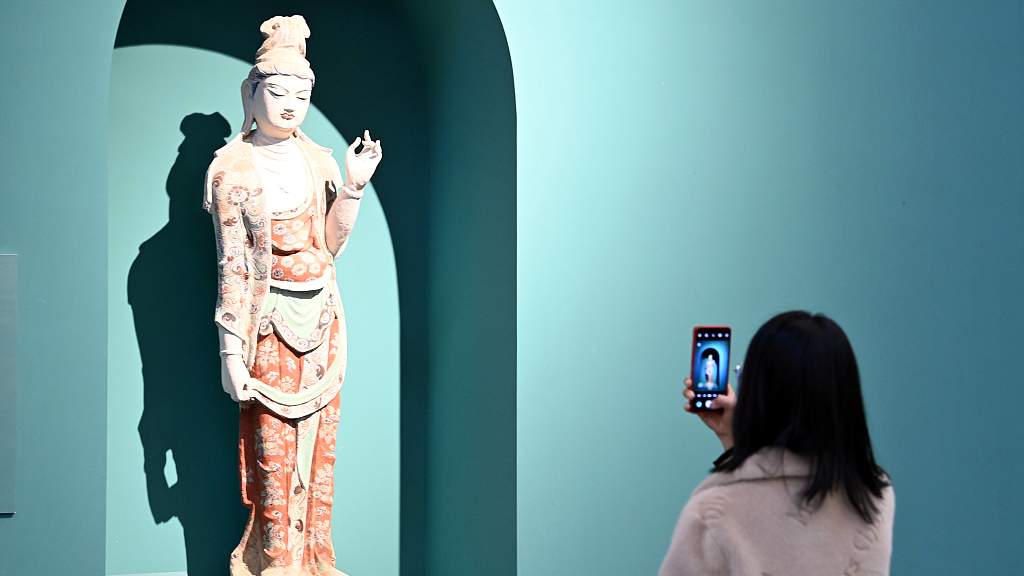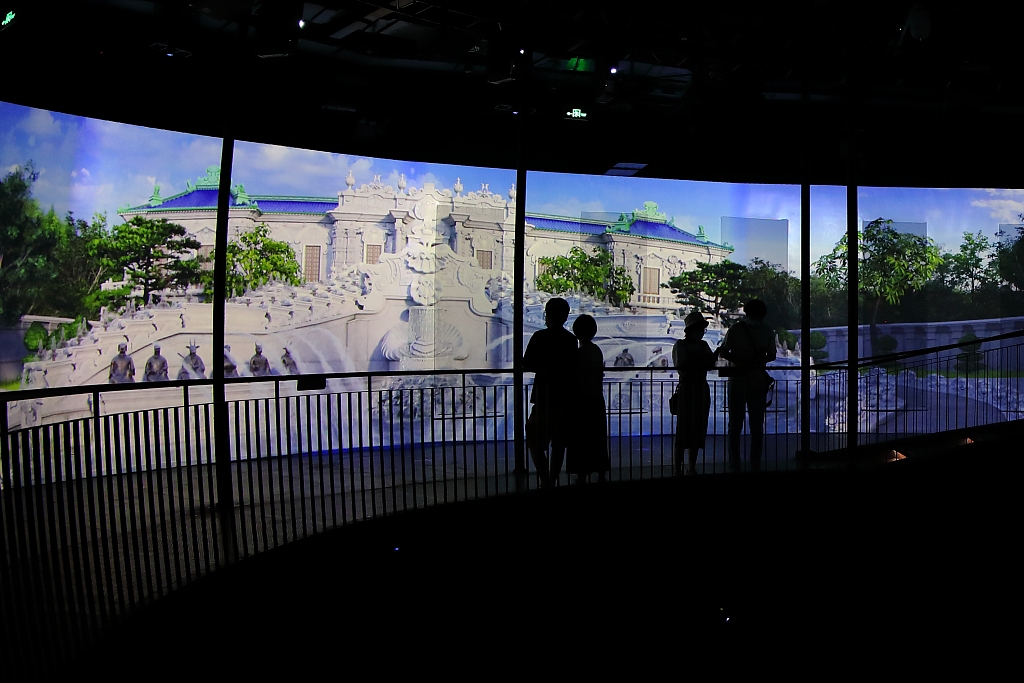
A visitor takes photos of a 3D print of a Mogao Grottoes colored sculpture during an exhibition in Lanzhou, capital city of northwest China's Gansu Province, March 3, 2023. /CFP
A visitor takes photos of a 3D print of a Mogao Grottoes colored sculpture during an exhibition in Lanzhou, capital city of northwest China's Gansu Province, March 3, 2023. /CFP
Editor's note: He Yan is the director of the Digital Heritage Committee of ICOMOS China, and President of Tsinghua Heritage Institution for Digitization. The article reflects the author's opinions and not necessarily the views of CGTN.
Cultural heritage serves as both a testament to and a vessel for the enduring legacy of civilizations. The dialogue it engenders, however, is fraught with barriers for those from different cultural backgrounds and even within the younger generation of its own nation. These barriers exist not only in space but also in time, requiring a transcendental understanding for deeper comprehension.
My experience suggests that this understanding could be fostered through active listening, engaged dialogue, insightful interpretation, and inspired creativity – a bridge that connects the epochs. The digital technology I work with offers immersive visual experiences, employing virtual reality as a tool for promoting communication. In essence, it serves as a translation of a different kind.
In general, I would like to share three key insights on this topic.
Firstly, there is a need to amplify the role of digital technology in preserving and interpreting cultural heritage. This interpretation could potentially generate new value, enhance public understanding, and pass down the valuable heritage to future generations.
Secondly, the mobility and visualization afforded by digital technology can facilitate international exchange and communication, enabling different cultural treasures to be experienced and shared by people all over the world more directly and conveniently.
Thirdly, this field is still emerging. The application of global digital technology to cultural heritage around the world can form a whole industry chain featuring digital content, smart equipment, and digital consumption. This has the potential to serve as the growth driver of the digital economy.
Take, for instance, our project of Digital Old Summer Palace. Once war-ravaged ruins, it's now digitally reborn, with restoration research outcomes being translated into a tangible, immersive digital space. The Old Summer Palace has metamorphosed from a symbol of humiliation into an accessible public heritage park; it's no longer a ruined civilization.

Tourists watch a screen that digitally recreates the Old Summer Palace during an exhibition in Shougang Industrial Heritage Park in Beijing, capital of China, July 12, 2020. /CFP
Tourists watch a screen that digitally recreates the Old Summer Palace during an exhibition in Shougang Industrial Heritage Park in Beijing, capital of China, July 12, 2020. /CFP
By digitally reconstructing the splendor of the Old Summer Palace, we've also illustrated the significant transformation of China's national strength over the past century. The initial phase of the project entailed the digital archiving and the virtual return of cultural relics lost overseas. Every interpretation is grounded in research. Collections in the United Kingdom, France, the United States, and beyond have digitally returned to China. This immersive environment invites the public to perceive, to engage, to ponder, and to gain a deeper understanding of the story behind the Old Summer Palace.
On the subject of dialogue between civilizations, I'd like to cite two examples. One is the Olympia project, exploring how Greek heritage is narrated in China. The other is the Digital Terracotta Warriors, depicting how Chinese heritage is narrated in Athens. In the Olympia project, we encapsulated the theme and cultural values as "a millennium feast of life," presenting it in Shougang Industrial Heritage Park in Beijing. The curatorial process involved deep collaboration with Greek experts while engaging with a variety of international experts and children through research and study courses.
We've carried out many cross-cultural interpretations. For instance, during the Mid-Autumn Festival last year, we designed mooncakes featuring both China's moon goddess Chang'e and Greece's moon goddess Artemis, creating intricate cross-cultural products.
The exhibition won accolades from Greek experts. They felt that we truly understood their culture. Therefore, I believe that mutual respect is very important in cross-cultural exchanges.
Similarly, when our Terracotta Warriors were showcased in Greece, we had the challenge of presenting them in a fresh light – not displaying a traditional military might, but expressing artistic beauty and inherent elegance. Our choice was to present the painted terracotta warriors. Both parties put on the table their finest digital resources and products, curating a virtual exhibition where Chinese generals and Greek soldiers could engage in a dialogue transcending time and space.
This innovative approach helped construct a shared understanding. By offering an in-depth interpretation of China's tech-enabled preservation work among other aspects, audiences could appreciate the stories behind the cultural heritage preservation efforts in both China and Greece. This approach has also generated a meaningful impact across society.
We are currently contemplating the establishment of a joint digital heritage laboratory with Greece, hoping to build a better point-to-point dialogue between civilizations. This initiative would encompass related scientific research, ranging from archaeology, architectural preservation and digital mapping, to digital creativity and even artificial intelligence. The knowledge in all these fields can apply and grow on this platform.
In conclusion, with the help of technology, cultural development still has a long and exciting journey ahead.
China Institute for Innovation and Development Strategy also contributed to this article.
(If you want to contribute and have specific expertise, please contact us at opinions@cgtn.com. Follow @thouse_opinions on Twitter to discover the latest commentaries in the CGTN Opinion Section.)